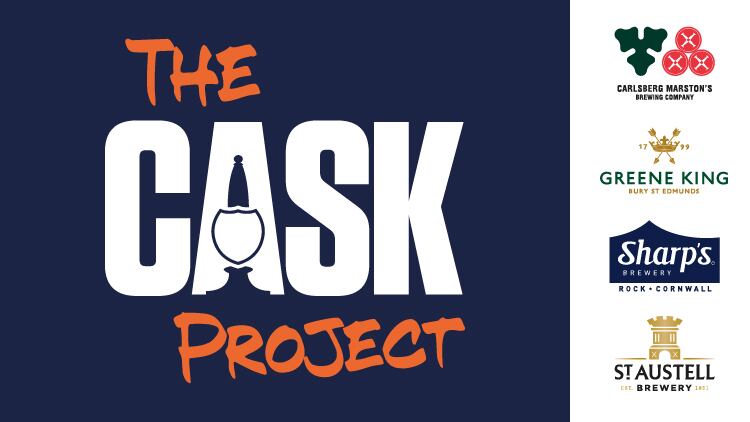Top pairing tips
1. Treat beer like wine. Take the time to taste it properly – swill it, smell it, sip it. Respect it
2. Match lighter beers with lighter flavours and darker beers with fuller flavours.
3. Encourage your staff to be inquisitive – ask them to taste your range of beers with different dishes and recommend pairings (theoretical matches don’t always work)
4. As well as matching your beer with food, use beer as an ingredient in your cooking for a more advanced integration of flavour.
So how can we do more as an industry to excite the public about the possibilities for beer and food matching and boost sales in the process?
Cask beer, in particular, is a perfect match for food due to the vast range of flavours, styles and textures and the fact it’s low in carbonation (so there’s less risk of feeling boated than with a lager or kegged beer). And with so many cask beers available, including seasonal and limited editions, there’s plenty of scope to switch up pairing suggestions on a regular basis and keep your customers coming back for more. So why don’t we engage our staff in promoting beer with food?
Some perceived barriers that I’ve heard quoted include:
“It’s not something we’ve ever done” – with current economic conditions, we need to explore every angle for making the pub a uniquely exciting place to visit, with new and interesting experiences.
“Our customers aren’t interested” – we have been running beer and food pairing activities at the brewery, in pubs and at events for years, and it’s always exciting to see a non-beer drinker get a new perspective on beer, in general, and just how well it can pair with food. Even if people assume it’s not for them, it’s almost always a positive reaction to being served a delicious beer and food combo or engaging in an activity that helps them explore flavour. The pub is a sociable place and sometimes people just need encouragement to try different things or join a conversation.
“We don’t know where to start” – this is where we have to hold our hands up as an industry and admit we have not kept up with wine in terms of educating and inspiring customers to pair our products with food. I can’t think of a brewer, however, that would not be delighted to talk to you about their beer, the ingredients that go into making it and the flavour notes (many will also suggest food pairings).
“We don’t have the time” – you don’t need to spend hours and hours training your staff on flavour matching. Pour samples of your beer range and have some tasters of dishes from your menu and see what works with what. Get the taste notes from the brewery website or ask your team what they can taste and smell, and devise your own. And whenever a new cask beer comes in, ask your staff (including your chefs) to taste it and think about what dish it would pair with and add a note to the menu or put it on a specials board.
Once your staff are more invested and confident in talking to customers about beer with food, why not bring customers along for the journey? Perhaps offering samples of beer with their food to see which they think works best. You may just discover a perfect combination and, if not, you’ve opened a dialogue and added value for your customer.
Pairing cheese and beer is perhaps the simplest way to start beer and food matching. The options are almost endless and beer is an excellent accompaniment to cheese, cutting through the fat. Beer is also a great ingredient in chutney so why not try creating your own ‘house chutney’ using your favourite cask ale, in addition to suggesting pairings for each cheese, to take your cheeseboard offering to the next level.
However you choose to approach it, we need to get better at having conversations around beer and food and inspiring customers to think about our national drink as something wonderful to enjoy alongside a delicious meal in the great British pub. Start a dialogue with your account manager, your brewery, your staff and your customers – the time invested should pay for itself in terms of team engagement, customer perception of your outlet and ultimately sales of beer and food.

There are no wrong ways to do it
We believe there are no hard and fast rules to beer & food pairing. It’s important not to feel constrained by anything other than what tastes great together, and experimentation is key.
As a general guide, think about beer and food pairing just like wine and food. If you’d serve a crisp white wine with a certain dish, swap it for a refreshing, lighter beer. For meals that go best with full-bodied reds, try amber or dark ales to balance the more robust flavours. Remember that each palate is different, so what works for one person might not work for another. And theoretical pairings don’t always work so (although it sounds obvious), it’s essential you taste the beer and food together before suggesting a pairing.
Take into consideration a few of the qualities of the beer:
Body
Does your dish lend itself to a light, dry beer, or a full-bodied bitter? Generally, beer with a full body will work better with richer foods, such as creamy dishes or cheese. A delicate, crisp beer tends to go better with lighter dishes, yet it can also counterbalance fatty or salty foods.
Spice
Cask beer can work particularly well with spicy food. Where carbonated beer such as lager can accentuate the heat of the chilli, cask can offer a smoother mouthfeel to sooth the palate.
Bitterness
Bitter notes in cask beers can offer loads of refreshment, especially when paired with salty or fatty food. Bitterness can also balance out sweet foods; for example, try Stout with chocolate, or a hoppy IPA with cake.
Sweetness
Those lovely, malty, sweet tones in a beer such as Doom Bar match with many different foods, but are especially good with spicy, sweet and rich foods.
Beer as an ingredient
You can substitute beer for water, wine, stock – any liquid ingredients – to add a twist to your dish. Use it in place of water in a batter, or use it for brining, basting, braising and dressing.




